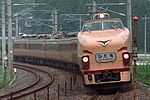203 series
| 203 series | |
|---|---|
 203 series train at Kanamachi Station, 31 July 2009 | |
| In service | 1982–September 2011 |
| Manufacturer | Kawasaki Heavy Industries, Kinki Sharyo, Tokyu Car Corporation |
| Constructed | 1982–1986 |
| Number built | 170 vehicles (17 sets) |
| Formation |
10 cars per trainset (JNR, JR) 8 cars per trainset (KCJ) 4 cars with a generator hauled by a locomotive (PNR) |
| Fleet numbers | 51–58, 61–69 |
| Capacity | 528 |
| Operator |
JNR (1982–1987) JR East (1987–2011) KRL Jabotabek (2011–) PNR (2012–) |
| Depot(s) | Matsudo |
| Line(s) served |
Jōban Line, Tokyo Metro Chiyoda Line (JNR, JR East) Jabodetabek Lines PNR Metro Commuter |
| Specifications | |
| Car body construction | Aluminium |
| Car length | 20,000 mm (65 ft 7 in) |
| Width | 2,800 mm (9 ft 2 in) |
| Doors | 4 pairs per side |
| Maximum speed | 100 km/h (60 mph)[1] |
| Traction system | MT60 (150 kW) x 24 |
| Acceleration | 3.3 km/h/s |
| Deceleration | 3.3 km/h/s |
| Electric system(s) | 1,500 V DC |
| Current collection method | Overhead catenary |
| Safety system(s) | ATS-Sn, ATC-10 (JNR, JR East) |
| Track gauge | 1,067 mm (3 ft 6 in) |
The 203 series (203系) is an electric multiple unit (EMU) train type operated in Japan between 1982 and 2011 by Japanese National Railways (JNR) and later by East Japan Railway Company (JR East), and currently operated by KRL Jabotabek in Indonesia and Philippine National Railways (PNR) in the Philippines.
Operations
The 203 series sets were on through services between the Jōban Line and Tokyo Metro Chiyoda Line until they were replaced by E233-2000 series EMUs, and finally withdrawn from services in Japan in September 2011.
Formation
The sets were formed as follows.[2]
| Car No. | 1 | 2 | 3 | 4 | 5 | 6 | 7 | 8 | 9 | 10 |
|---|---|---|---|---|---|---|---|---|---|---|
| Numbering | KuHa 202 | MoHa 202 | MoHa 203 | SaHa 203 | MoHa 202 | MoHa 203 | SaHa 203 | MoHa 202 | MoHa 203 | KuHa 203 |
Cars 3, 6, and 9 were each fitted with one PS21 pantograph.[2]
Interior
-
Interior view, September 2007
-
Priority seating, November 2010
History
Withdrawal
The trains were gradually replaced by new E233-2000 series EMUs, and the last set ran in revenue service on 26 September 2011.[3]
Overseas operations
Indonesia
F_EMU.JPG)
Some former 203 series sets have been sent to KRL Jabotabek (KCJ) in Jakarta, Indonesia.
KRL Jabotabek trainsets were shortened from 10 to 8 cars with the removal of the former cars 5 and 6.
| Car No. | 1 | 2 | 3 | 4 | 5 | 6 | 7 | 8 |
|---|---|---|---|---|---|---|---|---|
| Numbering | KuHa 202 | MoHa 202 | MoHa 203 | SaHa 203 | SaHa 203 | MoHa 202 | MoHa 203 | KuHa 203 |
Philippines

In November 2011, three former 203 series sets were also shipped to the Philippine National Railways (PNR) in the Philippines.[4]
| Car No. | 1 | 2 | 3 | 4 |
|---|---|---|---|---|
| Numbering | KuHa 202 | MoHa 202 | MoHa 203 | SaHa 203 |
| Car No. | 1 | 2 | 3 | 4 |
|---|---|---|---|---|
| Numbering | KuHa 203 | MoHa 203 | MoHa 202 | MoHa 203 |
References
- ↑ JR全車輌ハンドブック2009 [JR Rolling Stock Handbook 2009]. Japan: Neko Publishing. 2009. ISBN 978-4-7770-0836-0.
- ↑ 2.0 2.1 JR電車編成表 2011夏 [JR EMU Formations - Summer 2011]. Japan: JRR. May 2010. p. 77. ISBN 978-4-330-21211-1.
- ↑ "203系が営業運転から離脱" [203 series withdrawn from revenue service]. Japan Railfan Magazine Online (in Japanese). Japan: Koyusha Co., Ltd. 28 September 2011. Retrieved 28 September 2011.
- ↑ "日本の中古電車に熱視線 9月に引退した通勤車両、フィリピンで第二の人生" [Commuter trains retired in September to live a second life in the Philippines]. Sankei News (in Japanese). Japan: The Sankei Shimbun & Sankei Digital. 26 November 2011. Retrieved 16 April 2012.
External links
| Wikimedia Commons has media related to 203 series. |
- JR East 203 series at the Wayback Machine (archived 17 June 2011) (Japanese)
| |||||||||||||||||||||||||||||
| |||||||||||||||||||||||||||||



